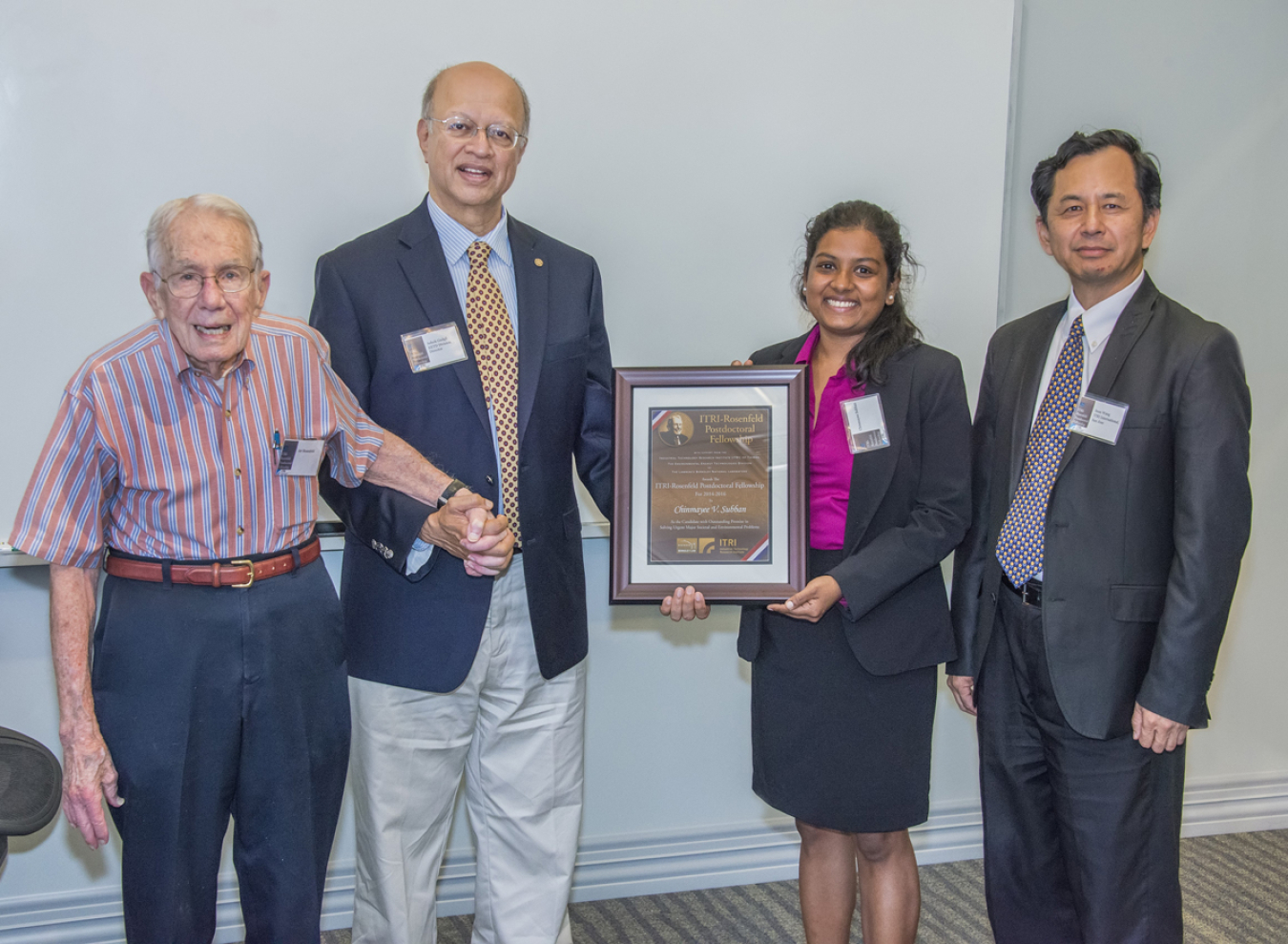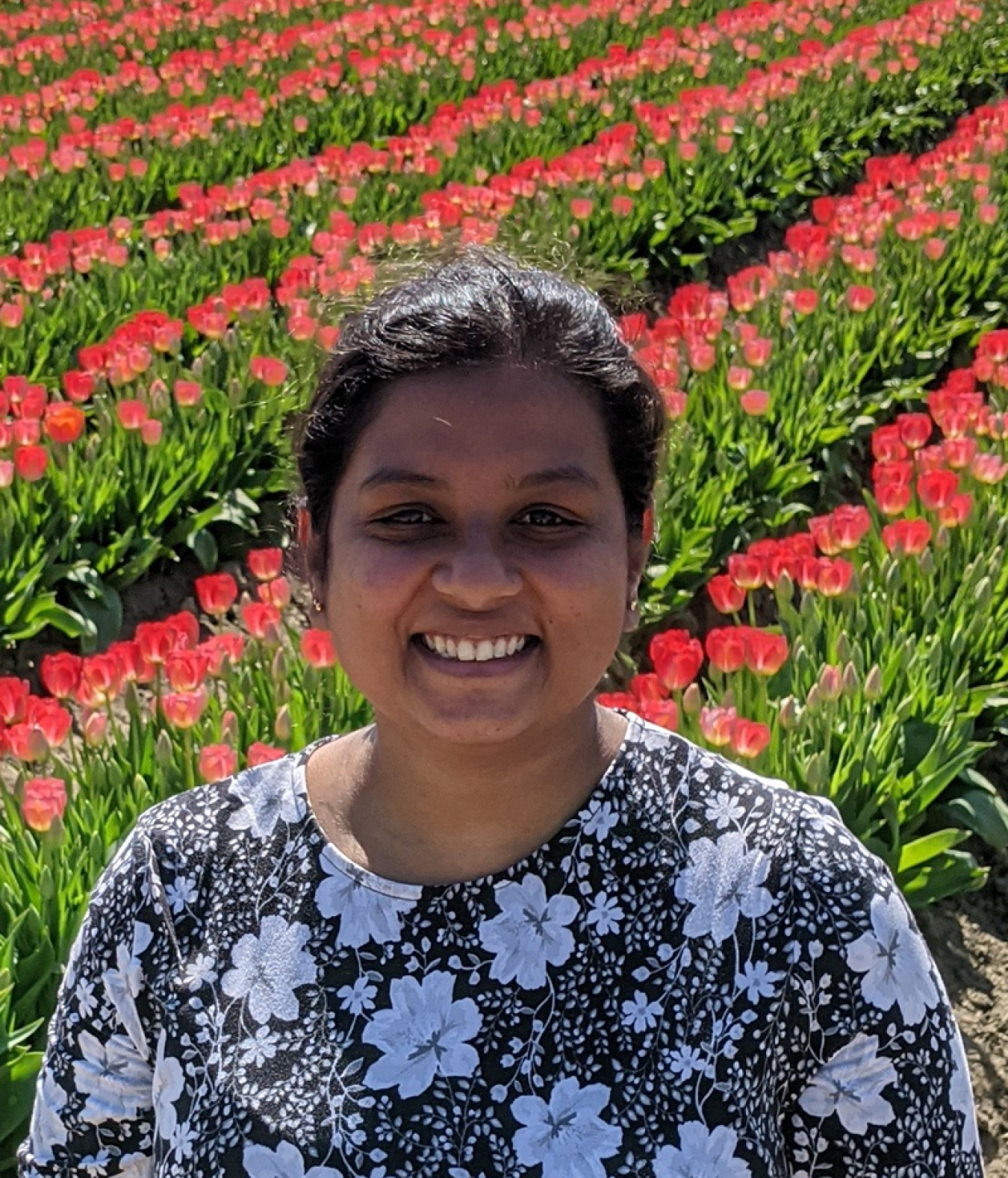Chinmayee Subban, a researcher at Pacific Northwest National Laboratory, shares what farmers taught her about water, how marine energy could power carbon capture, and how her daughter helps gauge how relevant her research is to broad audiences.
Water Power Technologies Office
February 22, 2024Chinmayee Subban is a talker.
Whenever the chemist settles into a seat on a crowded bus or train, she's always up for a chat with her fellow commuters. These conversations are more than just juice for Subban's social battery; they're like mini focus groups, guiding her toward research that's relevant to people, right now.
Ripple Effect
WPTO's Ripple Effect series features individuals whose impactful work will help advance hydropower and marine energy technologies to achieve a clean energy future.
When Subban chatted about some of her earlier research, like sequencing mushroom DNA or using guinea pigs to understand how opioids might affect newborns, her focus groups mostly shrugged. But when she shifted into energy, fuel cells, and batteries, the commuters perked up. They could relate. "My phone always dies so quickly," Subban remembers one saying.
But when she started to talk about water, that's when people really leaned in, eager to learn all they could.
"I was in California at that point and water was a very hot topic," Subban said. "But also, growing up in India, I was very aware of water stress."
Today, Subban is a researcher in the Coastal Sciences Division of the Pacific Northwest National Laboratory (PNNL) and an affiliate assistant professor at the University of Washington. Her water work has expanded to include a vast range of water-related technologies and solutions: She builds technologies that could help farmers or coastal communities use alternative water sources (like brackish or salty groundwater). And she partners with companies and coastal communities to create devices that use renewable energy from the ocean to make clean drinking water, remove carbon dioxide from the ocean or air, mine minerals from ocean water, or keep coastal ecosystems healthy.
Subban shared what California farmers taught her about water, how marine energy could power carbon capture, and how her 4-year-old daughter provides another gut-check to gauge how relevant her research is to broader audiences.

During her time at the Lawrence Berkeley National Laboratory, Chinmayee Subban won an Industrial Technology Research Institute of Taiwan-Rosenfeld Postdoctoral Fellowship award for her work on electrode materials for fuel cells and lithium-ion batteries. Photo by Roy Kaltschmidt, Lawrence Berkeley National Laboratory
How did you end up working on research related to water?
In graduate school, I ended up working on materials for fuel cells and batteries. At some point, I realized that if I made a new catalyst or electrode, it would end up in a publication or patent. But new materials rarely get incorporated into actual devices. You put in all this effort, and the impact could be very limited. That bothered me. So, I decided to work on water.
I expect water also has niche research topics, so I assume you chose to focus on something that could have broad impact.
Yes, I worked on desalination and water treatment—stuff that was becoming increasingly important. I ended up spending a lot of time driving around the Central Valley of California talking to farmers about their water needs. It was right after a drought, and water was a sensitive topic. The news was talking about how almonds were consuming so much more water than anything else—and some of these farmers grew almonds.
Were you able to help the farmers find solutions? I know you’ve worked on finding ways to use alternative water sources, like brackish or salty groundwater.
I learned a lot about farming water use and needs, and I built trust with some of them. Because national labs are neutral parties, our staff can be really valuable to these communities. We try to understand their concerns, so we can help solve them. I went back to tour their farms and get water samples. And I brought other academics, so they could see what a real operation looks like. In the lab, it's very easy for us to build our devices. But understanding what the farmers care about was so important. It informed our brackish water project and shaped how I think about my research today. Not "build it and they will come," but "build what somebody actually wants."
Now, you work on much more than desalination. How did you branch out to study all kinds of water-related technologies?
I use my chemistry skills to research different water-related technologies. In general, whether you're extracting minerals or energy from water or making fresh water, you have to think about cost and energy efficiency. To achieve those goals, you often need to build systems that combine multiple water-related technologies. For example, many countries around the world have access to seawater. But it takes a lot of energy to pump and use seawater, so what are all the things you could get out of it since you've invested that energy?
Meaning, you find ways for one technology to serve multiple purposes, like generating clean energy or clean water or extracting minerals, so the whole system is more valuable?
Yes. There's a lot more continuity between these topics than it might seem. For example, I support a lot of projects in marine carbon dioxide removal, which involves extracting carbon from ocean water to reduce the amount of excess carbon dioxide we have in our world. Those systems use membranes that are very similar to desalination. Another example is salinity gradient energy, a type of marine renewable resource that can be used to generate energy from the differences in salt levels in water. For that, you mix salt water and fresh water, which is the opposite of desalination. They’re all connected. Often, it's about looking for creative ways to apply existing materials and technologies to new applications.
You also do a lot of work to integrate communities into technology development, right?
Right now, one of my marine carbon dioxide removal projects entails understanding community and regulatory concerns around technology deployment. That can be a very complicated space to be in, but it fits my philosophy to engage with communities early and understand their needs and concerns.
We’re partnering with about 20 companies, several coastal communities, including coastal Tribes, subject-matter experts, and regulatory bodies to bring all these pieces together at a very critical time. Marine carbon dioxide removal is getting a lot of attention, but it's in the very early stages of development. We need to establish the right regulatory framework for incentives to ensure rapid yet responsible deployment of ocean-based carbon removal.
Have any barriers surprised you?
As individuals, we don't think climate change is our problem. We think of it as a global issue. Chances are communities will not think of marine carbon dioxide removal as a way to address climate change. But if you couple marine carbon dioxide removal with a shellfish industry or seafood farming platform, they're more likely to be engaged. Communities are interested in how technologies might impact their current life and sources of income, not necessarily the carbon offset.
How could you couple marine carbon dioxide removal and seafood farming?
One electrochemical carbon capture method generates an acid and a base. The base goes back into the ocean to capture carbon. It reduces ocean acidification locally, which is good for shellfish farming. And we found a way to use the acid onshore to increase algae cultivation rates. Algae can capture additional carbon and could be used as oyster food. So, if marine carbon dioxide removal is coupled with seafood farming, instead of buying algae paste for oysters, farmers could grow it, while potentially extracting some minerals from seawater, improving water quality for their shellfish farming and capturing carbon. And we could power either the sensors or the systems with marine energy. That's the kind of integration I'm looking for.

Subban still relies on nonscientists to assess whether her research is relevant enough. Her latest focus group addition is her 4-year-old daughter, Anvaya. Photo courtesy of Chinmayee Subban
Tell us more about powering these systems with marine energy: How would that work? And why is marine energy a valuable option for these technologies?
A lot of carbon capture systems use sensors to monitor water quality and ensure their system is healthy and operates efficiently. And because these sensors have fairly low power needs, they're well suited to couple with marine energy. Today, carbon capture systems are being tested in coastal regions. But to remove enough carbon to make a difference, they'll have to be deployed in the open ocean. At that point, marine energy will be an especially attractive option to power these systems.
In an ideal world, if you could accomplish anything, what would you most want to accomplish?
I used to use my mom as a metric to gauge how relevant my work is to the broader public. But now I use my daughter, Anvaya. She's 4 years old. We’re trying to show her how the world is changing. We listen to the news and talk about climate events. My daughter actually named one of my projects; she came up with an easy-to-understand description and frequently asks about our progress! I aspire to communicate what I do to folks aged 4 or 40 or 80 . That's what keeps me going.
What advice do you have for the next generation of folks who might want to follow in your footsteps?
You have to be excited about the day-to-day work, not just the big vision. A lot of people are interested in saving the world or preventing climate change. But when they realize that day to day, you're synthesizing a material, coating it on a plate, and testing it in the lab in front of a machine all day… that doesn't get them excited. But that's part of the work that needs to be done to get where we need to go.
Catch up on WPTO's other Ripple Effect profiles and the Office of Energy Efficiency and Renewable Energy's Clean Energy Champions.
And stay in the know with WPTO! Receive the latest information on funding opportunities, events, and other news by subscribing to the Hydro Headlines newsletter, as well as the Water Column and comprehensive Water Wire newsletters.

